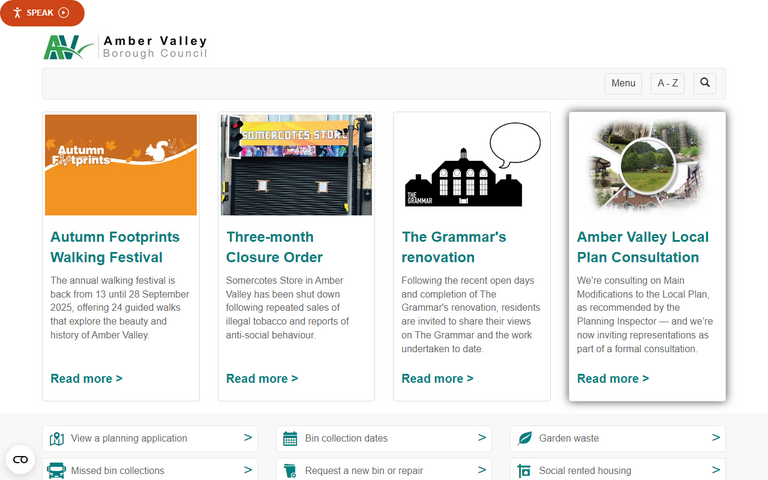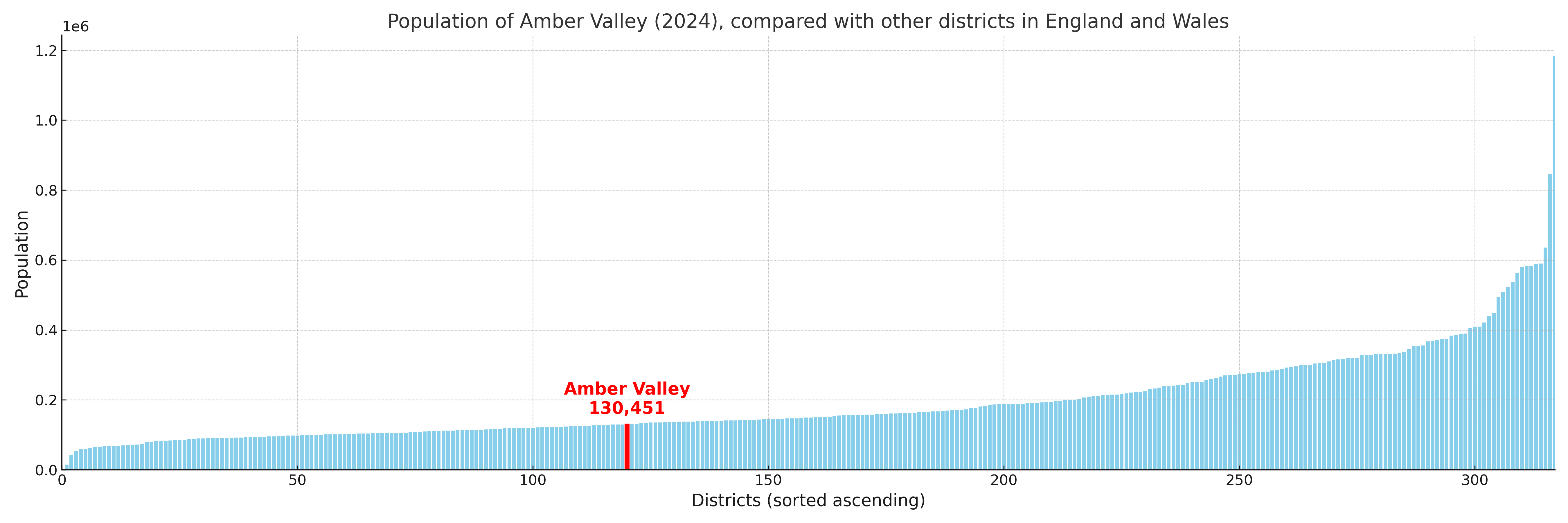Amber Valley
§ This page gives an overview of the Amber Valley local authority district, bringing together key facts, maps, and data to help you quickly understand the area. One of 361 district profiles on Baseview.
Overview ⁞ Amber Valley in Derbyshire is named after the River Amber that runs through its picturesque landscape of rolling hills, woodlands, and villages. The market town of Alfreton sits to the north, while Ripley, Heanor, and Belper provide vibrant hubs of industry and heritage, with Belper’s historic mills forming part of the Derwent Valley Mills UNESCO World Heritage Site. The countryside is dotted with traditional stone-built villages, nature reserves, and scenic walking trails, while the proximity to the Peak District adds to its rural charm. The area also has historic ties to the textile industry, reflected in preserved mills and waterways that shape the district’s character.
Amber Valley Boundary Map
This map shows the official boundary of the Amber Valley local authority district, based on the latest geographic data published by the Office for National Statistics (ONS). It provides a clear view of the district’s extent and helps you understand how the area fits within the wider regional and national landscape.
Contains OS data © Crown copyright and database right 2025. Source: Office for National Statistics licensed under the Open Government Licence v3.0.
The administrative boundary of Amber Valley can also be viewed on OpenStreetMap: District Boundary of Amber Valley.
Key Facts about Amber Valley
What region is Amber Valley in? Amber Valley is in the East Midlands of England, a region within the UK.
What county is Amber Valley in? Amber Valley is located in the county of Derbyshire.
Is Amber Valley a city? No, Amber Valley is not a city. (Note: the UK has 76 officially designated cities.)
Who governs Amber Valley? The local authority for this district is: Amber Valley Borough Council - responsible for district-level services. Since Derbyshire is a two-tier area, county-level services are handled by: Derbyshire County Council.
▶ Official website of Amber Valley Borough Council 🔗 ambervalley.gov.uk

Which police force covers Amber Valley? Policing in Amber Valley is provided by Derbyshire Constabulary 🔗 derbyshire.police.uk, which serves 9 local authority districts: Amber Valley ⁞ Bolsover ⁞ Chesterfield ⁞ Derby ⁞ Derbyshire Dales ⁞ Erewash ⁞ High Peak ⁞ North East Derbyshire ⁞ South Derbyshire.
Constituencies in Amber Valley
Amber Valley is divided into 3 parliamentary constituencies, listed below in alphabetical order.
A constituency is a specific geographical area that elects one Member of Parliament (MP) to represent them in the House of Commons. The United Kingdom is divided into 650 parliamentary constituencies. We have this list page for easy browsing of all UK parliamentary constituencies: List of Constituencies.
Wards in Amber Valley
Amber Valley is divided into 18 wards, listed below in alphabetical order.
- Alfreton
- Alport & South West Parishes
- Belper East
- Belper North
- Belper South
- Codnor, Langley Mill & Aldercar
- Crich & South Wingfield
- Duffield & Quarndon
- Heage & Ambergate
- Heanor East
- Heanor West & Loscoe
- Ironville & Riddings
- Kilburn, Denby, Holbrook & Horsley
- Ripley
- Ripley & Marehay
- Smalley, Shipley & Horsley Woodhouse
- Somercotes
- Swanwick
In the UK, a ward is a subdivision of a local authority area, used mainly for electoral and statistical purposes. Defined by the ONS, wards represent the primary unit for local elections, each returning one or more councillors to the local council. Wards are also used as a key geography for presenting population and census data.
Parishes in Amber Valley
Amber Valley is part-parished: 35 civil parishes (listed A-Z below) alongside 2 unparished areas.
- Aldercar and Langley Mill
- Alderwasley
- Alfreton
- Ashleyhay
- Belper
- Codnor
- Crich
- Denby
- Dethick, Lea and Holloway
- Duffield
- Hazelwood
- Heanor and Loscoe
- Holbrook
- Horsley
- Horsley Woodhouse
- Idridgehay and Alton
- Ironville
- Kedleston
- Kilburn
- Kirk Langley
- Mackworth
- Mapperley
- Pentrich
- Quarndon
- Ravensdale Park
- Ripley
- Shipley
- Shottle and Postern
- Smalley
- Somercotes
- South Wingfield
- Swanwick
- Turnditch
- Weston Underwood
- Windley
A civil parish is the lowest tier of local government in England, used for villages, small towns, and suburbs. They have their own local authority, either a parish council or a parish meeting, which provides local services like managing parks, allotments, and streetlights, and represents the community's views to larger councils.
Built-up Areas in Amber Valley
Amber Valley covers 33 built-up areas, listed below in alphabetical order.
- Alfreton *
- Ambergate
- Belper
- Crich
- Denby Bottles
- Denby Common
- Derby *
- Eastwood *
- Fritchley
- Heage
- Heanor *
- Holbrook (Amber Valley)
- Holloway (Amber Valley)
- Horsley (Amber Valley)
- Ilkeston *
- Ironville
- Jacksdale and Westwood *
- Kilburn and Horsley Woodhouse
- Little Eaton *
- Makeney *
- Milford (Amber Valley)
- Morley (Amber Valley) *
- Pye Bridge *
- Quarndon *
- Ripley (Amber Valley)
- Shipley (Amber Valley)
- Smalley
- Somercotes and Swanwick *
- South Normanton and Pinxton *
- South Wingfield
- Turnditch *
- West Hallam *
- Whatstandwell
In the UK, a Built-up Area (BUA) is a continuous urban area of at least 20 hectares (0.2 km²), defined by the ONS as land where buildings are generally no more than 200 metres apart, such as towns, cities, or large villages. (Note: A BUA name marked with an asterisk (*) indicates that the area is situated partly in the district of Amber Valley.)
Amber Valley compared with other districts in the UK
This section shows how Amber Valley compares with other local authority districts in the UK, using a variety of measures and rankings.
Amber Valley has 18 electoral wards.

Amber Valley has a population of 130,451 (2024 mid-year estimate by ONS)

More local statistics and data for Amber Valley can be found on the ONS statistics for Amber Valley.